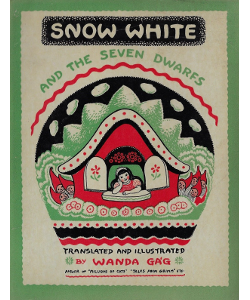Snow White and the Seven Dwarfs

Content:
Snow White
Illustrator:
Wanda Gag ![]()
Original language:
German
Translator:
Wanda Gag ![]()
Publication:
1938 by Coward, McCann & Geoghegan, Inc
Genre:
Fairy Tales, Fiction, Folk Tales
Pages:
44
Current state:
Basic information has been added for this book.
It is under consideration and will be updated when it is evaluated further.
Book Guide
Search for this book used on:
"It will be good news to many readers that Wanda Gag has made her own translation and pictures for Snow White and the Seven Dwarfs," writes Miss Anne Carroll Moore in the May-June Horn Book. "The story is as satisfying told in the pictures as it is in the words of the text. In both there is a childlike simplicity united with great strength and beauty. The inimitable drawings of the dwarfs restore their true character as dwarfs."
In a year that has been especially conscious of this tale, it is fitting that an authentic rendition of it should be made available for children who want the real Grimm story. That such an edition would fill a genuine need was felt by many people, particularly librarians, and in discussing the problem with Wanda Gág, Miss Moore suggested that she do the book.
As in her Tales From Grimm, Miss Gág went direct to the German for her text. Her translation is smooth and colorful and above all faithful to the original. The lovely pictures *** all the beauty, humor, and drama of the story. Here in prose and illustration is Snow White and the Seven Dwarfs as the Brothers Grimm set it down. Snow White is a real little princess; the seven dwarfs are exactly what dwarfs should be—kindly, hard-working, scrupulously clean; the wicked queen appears in all her cold, vain majesty. The creatures of the woods, the seven high hills, the queen's *** disguises, the dwarfs' clothes fluttering on the line, their nightshirts flung across their beds, their slippers on the floor—everying lives in *** pictures. This is a beautiful and timely book for both children and adults.
Uniform in format with Tales from Grimm.
From the dust jacket
To view an example page please sign in.
To view awards and booklists please sign in.
Please sign in to access the type of illustrations and view more books with this type.
To view reprints of this book please sign in.
Resource Guide
Episode 70: Why Read Fairy Tales?
Released in 2020 by The Literary Life
Available formats: Streaming Audio
Length: 1 hr. 29 min.
View on the The Literary Life site
"Angelina Stanford and Cindy Rollins tackle the topic of fairy stories, discussing the what, why and how of reading them. Angelina shares the distinctive characteristics of fairy stories in contrast to other types of stories, such as myths. They deal with the question of whether fairy tales are 'escapist', the influence of the Grimm brothers scholarly work on interpreting fairy stories, and allowing the story to unveil its deeper truths without forcing meaning onto it.
Angelina gives an illustration of how to see the gospel messages in fairy tales by talking us through the story of Sleeping Beauty. She refutes the ideas that fairy tales are about human romance or are misogynistic. She also highlights some of the Enlightenment and Puritan responses to fairy tales that still linger with us today. Cindy and Angelina also discuss some common concerns such as the magical, weird, or scary aspects of fairy tales. Angelina also makes a distinction between folk tales, literary fairy tales, and cautionary tales."
Find This Book
Search for this book used on:




